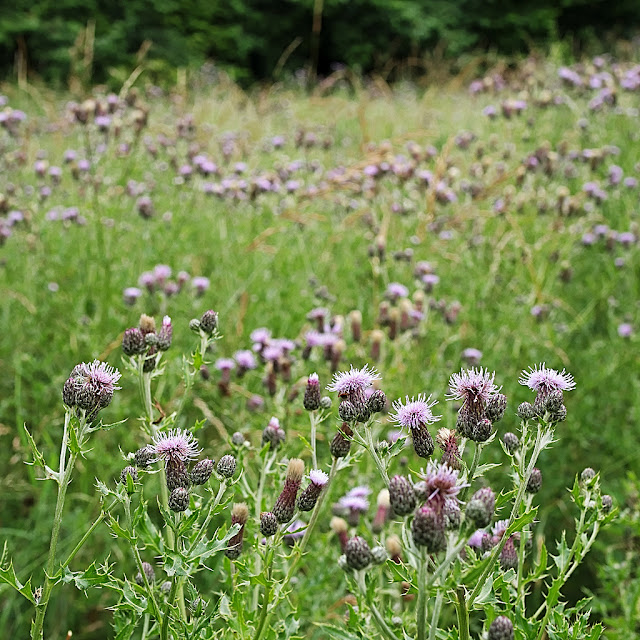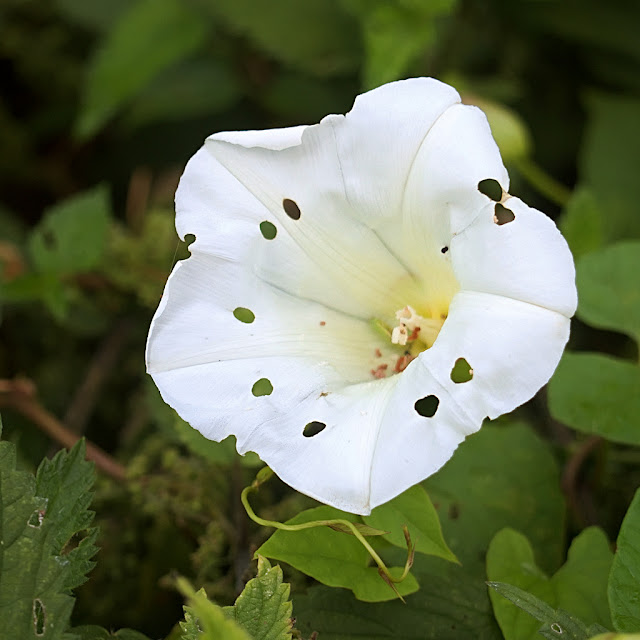After
the elder has finished flowering, the country park becomes
overwhelmingly green and will remain so until the leaves change
colour in autumn. However, there are a number of more or less
conspicuous plants flowering during the summer months.
 |
| Spear Thistle - 7 August 2016 The national flower of Scotland in Milton Country Park |
Thistles
The
main display of thistles is the small meadow on the left hand side of
the path leading to the Fen Road exit. These are creeping thistles, elsewhere there are
small isolated clumps of spear thistles, like the one shown above.
 |
| Meadow by Fen Road Exit - 10 July 2016 |
The
main claim to fame for the thistle is, of course, it is the national
flower of Scotland. Legend has it that in 1263, king Haakon of
Norway tried to invade and conquer Scotland. At some point, the
invading army tried to mount a surprise attack on their Scot enemies
under the cover of darkness. In order to be as quiet as possible,
the attackers took off their shoes and advanced in bare feet. One
unfortunate soldier trod on a thistle, yelled with pain, and woke the
sleeping Scots, who went on to defeat the Norwegians at the Battle of
Largs.
Hedge Bindweed
 |
| Hedge Bindweed - 31 July 2016 I have been unable to find out what eats the buds Probably one single bite and the culprit did not come back for more. |
Many
of the bushes at the north end of the park, particularly along the
north edge of Deep Pool, are covered with the white trumpet flowers
of bindweed for many weeks during summer. Close inspection shows
that individual blooms are quite short lived, but, at any one time,
only a small fraction of the buds are out - hence, the appearance of
continuous blossom.
 |
| North of Deep Pool - 31 July 2016 Everything from buds to dead heads on the plant |
It
seems a little strange, that a plant as common and conspicuous as
hedge bindweed seems to have attracted very little, if any,
folklore. Its only medicinal use seems to have been as a purgative.
It does have a couple of more imaginative alternative common names,
including: old man's night cap, wedlock, and granny-pop-out-of-bed.
This last from the fact that when the base of the flower is squeezed,
the whole corolla pops out.
Yellow Loosestrife
 |
| Dickerson's Pit - 10 July 2016 |
I
have only found a couple of clumps of yellow loosestrife in the park,
both of which are in the small inlet off the north west corner of
Dickerson's Pit.
The derivations of the both the English and Latin names for yellow loosestrife are interesting.
The
name 'loosestrife' probably comes from a belief that putting some of
the plant under the yolk of oxen would calm them down. Like much
folklore this seems to have more than a little basis in fact:
loosestrife is repellent to flies, and hence is likely to calm
animals tormented by insects.
In latin, Lysimachia vulgaris is
named after King Lysimachus of Sicily who first discovered its
medicinal properties which included treatment of bleeding wounds.
Honeysuckle
 |
| Todd's Pit - 10 July 2016 Victorians believed its heady scent gave young girls inappropriate dreams |
I
had smelt a sweet aroma at the north-west corner of Todd's Pit before
I spotted its source: this vine of honeysuckle growing among the
willows.
And,
perhaps, because of its sweet smell, the ancients could find no evil
with it; it was a force wholly for the good. Plant it in your garden
and around your doorways and it will ward off witches and evil. Take
honeysuckle indoors and your marriage will prosper.
The
leaves of honeysuckle which have been used for treating coughs, colds
and asthma, contain antibacterial and anti-inflammatory compounds.
These are little used today because of the overall toxicity of the
plant.
But,
spoil sports that they were, the Victorians could not let such
unbridled good cheer go completely unchecked. They banned young girls
having the flowers in the house in case their heady scent gave them
inappropriate dreams!
Next: More Summer Flowers
Next: More Summer Flowers
No comments:
Post a Comment